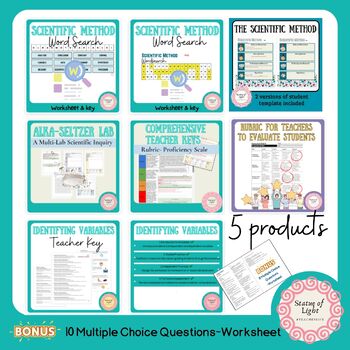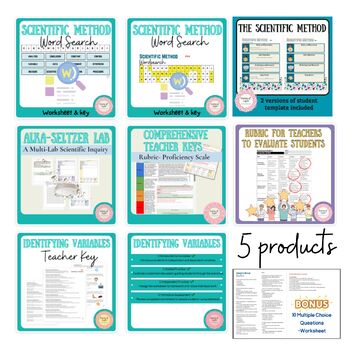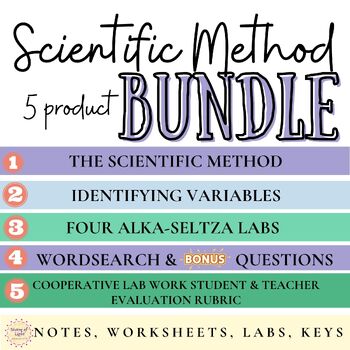Bundle: The Scientific Method-Notes/ Four Labs/Questions/Assessment/Word Search
- Zip
Products in this Bundle (5)
Bonus
Description
Product 1: The Scientific Method Guided Notes
These guided notes for The Scientific Method provide a step-by-step framework for students to understand and apply the scientific method. The notes are designed to be used as a teaching aid and are perfect for use in both classroom and homeschool settings. Each step in the scientific method is explained clearly and concisely, using easy-to-understand language that students can relate to. With this resource, you can be confident that your students will be well-prepared to tackle any scientific investigation they encounter.
Product 2: Identifying Variables
Introduce your students to the fundamentals of experimental design with this Identifying Variables Worksheet. This straightforward resource contains 10 lab scenarios, guiding students to identify the independent and dependent variables, along with what needs to be kept constant. Tailored for beginners, this worksheet is an ideal tool for introducing the concept of variables in scientific experiments. Whether used independently or as part of a larger lesson, this worksheet will help students develop a solid understanding of experimental design principles
Ideas for Classroom Use:
1. Introduction to Variables: Use the worksheet as a starting point to introduce students to the concepts of independent and dependent variables. Guide them through the scenarios, discussing each variable's role in the experiments.
2. Guided Practice: Facilitate a classroom discussion where students work through the scenarios together. Provide guidance and support as they identify the variables and discuss why certain factors need to be kept constant.
3. Independent Practice: Assign the worksheet as homework or an in-class activity for students to complete independently. This allows them to apply what they've learned and reinforce their understanding of experimental design principles.
4. Formative Assessment: Use the completed worksheets to gauge students' comprehension of variables and experimental design. Review their responses to identify any areas where additional instruction or clarification may be needed.
5. Extension Activities: Encourage students to create their lab scenarios or design experiments based on the principles learned from the worksheet. This promotes critical thinking and creativity while further reinforcing their understanding of variables.
Overall, this worksheet provides a hands-on, practical approach to teaching experimental design, allowing students to actively engage with the material and develop essential scientific inquiry skills.
Product 3: Alka-Seltzer Tablet Dissolving: Exploring Factors for Faster Fizzing - A Multi-Lab Scientific Inquiry
This multi-page resource applies the scientific method to investigate the effects of temperature, surface area, stirring, and pH on the rate of Alka-Seltzer tablet dissolution across four engaging experiments.
Students will formulate hypotheses, identify variables (independent, dependent, and control), list materials, outline procedures, record data, and analyze results using graphing techniques.
With guiding questions and a full teacher key included, grading is made easy based on a proficiency scale. Phrases for assessment are provided to assist teachers in evaluating student work. Perfect for reinforcing scientific inquiry skills, the Scientific Method, and promoting critical thinking in the classroom.
Lab 1. Investigates the effects of temperature
Lab 2. Explores the impact of surface area
Lab 3. Examines the influence of stirring
Lab 4. Considers the effect of pH
Key Points:
1. Comprehensive exploration of the Scientific Method.
2. Investigate multiple variables affecting Alka-Seltzer tablet dissolution.
3. Engages students in hypothesis formulation and experimental design.
4. Facilitates data analysis and graphing skills development.
5. Teacher key with a grading rubric and assessment phrases.
6. Promotes critical thinking and scientific inquiry.
7. Encourages hands-on, inquiry-based learning experiences.
8. Fosters collaborative learning through group experimentation.
Classroom Use Checklist:
1. Introduce lab as a hands-on investigation of chemical reactions.
2. Guide students in formulating hypotheses and identifying variables.
3. Demonstrate proper lab techniques and safety procedures.
4. Monitor student progress and assist as needed.
5. Use guiding questions to facilitate data analysis and interpretation.
6. Encourage students to graph their results and draw conclusions.
7. Use the provided teacher key and rubric for grading and feedback.
Product 4: The Scientific Method Word Search Worksheet, Vocabulary, Key Words Review
Engage your students with our Scientific Method Wordsearch Worksheet! This straightforward activity challenges students to find 12 hidden words related to the scientific method. Perfect for reinforcing vocabulary and promoting active learning, this resource is ideal for science classrooms of all levels. With clear instructions and a focus on key scientific concepts, this word search offers a fun and educational way to review the scientific method. Use it as a warm-up activity, homework assignment, or as part of a lesson on scientific inquiry. Download now and add some excitement to your science curriculum! Check out my store for other related products on the scientific method.
Product 5: Rubric Self-Assessment Cooperative Lab Work Rubric
Page 1: Cooperative Lab Work Rubric for Students:
- This rubric enables students to self-assess their performance in cooperative lab settings. It assesses key aspects such as following instructions, staying organized, being a good lab partner, adhering to lab procedures, and cleaning up. Students can use this tool to reflect on their collaborative skills and take ownership of their learning experiences in the lab.
Page 2: Cooperative Lab Work Rubric for Teacher Assessment:
- This rubric is designed to help teachers evaluate students' performance in cooperative lab environments. It assesses students on their ability to follow instructions, maintain organization, collaborate effectively with peers, adhere to lab procedures, and complete cleanup tasks. By using this rubric, teachers can provide targeted feedback to students and identify areas for improvement in their cooperative work during lab activities.
Key Points:
- Comprehensive Evaluation: Provides a thorough assessment framework covering essential aspects of cooperative lab work, including following instructions, organization, collaboration, adherence to procedures, and cleanup.
- Dual Purpose: Designed for both student self-assessment and teacher evaluation, fostering accountability and promoting reflective learning practices among students while facilitating efficient grading for teachers.
- Clear Criteria: Clearly defined criteria and performance levels enable students to accurately gauge their performance and progress in cooperative lab settings, while also facilitating consistent and objective evaluation by teachers.
- Promotes Student Ownership: Empowers students to take ownership of their learning experiences by engaging in self-assessment, setting goals for improvement, and actively participating in the evaluation process.
- Encourages Collaboration: Fosters a collaborative classroom environment where students work together, support one another, and contribute to the collective success of the lab group.
Bonus Product: 10 Multiple Choice Questions on the Scientific Method, with an Answer Key. Use for homework, review, practice, or for a quick assessment.





